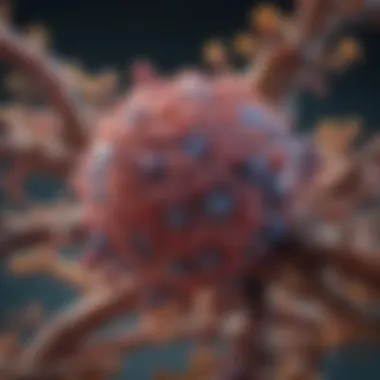Understanding P62: Roles and Implications in Biology


Intro
In the realm of molecular biology, understanding proteins like p62 can shed light on many critical cellular processes. P62, also known as Sequestosome 1, plays a crucial role in autophagy, a cellular mechanism responsible for regulating homeostasis within cells. This article delves into the multifaceted nature of p62, examining its structural characteristics, functions, and implications in a variety of health-related issues. From its involvement in cellular stress responses to its impact on various diseases, p62 emerges as a focal point for contemporary research and therapeutic avenues.
Key Concepts
Definition of the Main Idea
P62 is a multifunctional protein that operates within the autophagic process. It acts as a scaffold that interacts with various partners, including ubiquitin proteins, to facilitate autophagy. Its ability to bind to and sequester cargo for degradation ensures the removal of damaged cellular components. This process is essential for maintaining cellular health and preventing diseases caused by cellular debris accumulation.
Overview of Scientific Principles
At its core, p62 facilitates selective autophagy. This is the process of degrading specific cellular constituents in response to different stressors. Understanding how p62 participates in this process requires an appreciation for several key scientific principles:
- Ubiquitination: The tagging of proteins to signal their degradation or processing.
- Autophagosome Formation: The creation of double-membrane structures that engulf cellular debris.
- Lysosomal Degradation: The breakdown of cellular components through lysosomal enzymes.
These processes illustrate the intricate network of interactions within cells, positioning p62 at the center of autophagic activity.
Current Research Trends
Recent Studies and Findings
Research surrounding p62 has escalated in recent years. Significant studies have demonstrated its role in neurodegenerative diseases, such as Alzheimer's, where the accumulation of misfolded proteins poses a risk to cellular integrity. Recent findings suggest that promoting p62-mediated autophagy could provide therapeutic benefits for patients suffering from such conditions.
- Study A highlighted the correlation between p62 levels and cognitive decline in Alzheimer's patients.
- Study B examined how p62 influences inflammation in multiple sclerosis, providing insights into its broader health implications.
Significant Breakthroughs in the Field
Major breakthroughs have been achieved regarding p62's function in aging and metabolism. The protein has been implicated in the regulation of energy homeostasis, linking autophagy processes to metabolic efficiency. Moreover, advances in genetic editing technologies have enabled scientists to manipulate p62 levels in various models, unveiling its potential as a drug target for metabolic disorders.
"P62 serves as a nexus between cellular stress responses and autophagic processes, implying that targeting its pathways may revolutionize therapeutic strategies for complex diseases."
"P62 serves as a nexus between cellular stress responses and autophagic processes, implying that targeting its pathways may revolutionize therapeutic strategies for complex diseases."
As research continues to advance, the potential applications of p62 as a biomarker for disease progression are also being explored. Efforts to better understand p62's impact on human health insist on an ongoing commitment to unraveling its complexities.
Intro to P62
P62 protein plays a vital role in various cellular processes, making it an essential topic in molecular biology. Understanding P62 goes beyond just knowing a protein's name; it includes its functions, structural features, and implications in human health. Researchers have recognized P62's importance in maintaining cellular homeostasis and its various pathways, especially in contexts like autophagy and stress response.
Exploring P62 means diving into a nuanced subject. This article will elaborate on its structural characteristics, interaction with other proteins, and functionality. Moreover, it will explore how these aspects relate to several diseases, presenting P62 not only as a key player in health but also as a potential therapeutic target.
The following sections will offer readers a thorough understanding of P62, its historical significance, and the advancements in research that have shaped current knowledge. This foundation is critical, especially for students, educators, and professionals who seek to deepen their comprehension of molecular mechanisms in biology.
Defining P62 Protein
P62, also known as SQSTM1, is a multi-functional protein playing a crucial role in several biological processes. It serves as a signaling hub and is involved in the regulation of autophagy, which is important for cellular recycling and maintenance. P62's ability to bind to various proteins allows it to participate in diverse pathways, thus emphasizing its multifunctionality.
One of P62’s key features is its signaling capability; it manages the interactions between different cellular components. These interactions are vital in many cellular contexts, particularly under conditions of stress or nutrient starvation. By being able to sense cellular conditions, P62 contributes to maintaining homeostasis and responding effectively to environmental changes.
Furthermore, P62 operates as a scaffold protein, recruiting other proteins to specific cellular compartments, which is essential in cellular trafficking and signaling pathways. Understanding its precise functions can provide insights into its role in both normal physiology and pathological conditions.
Historical Context and Discovery


The discovery of P62 dates back several decades, with initial reports identifying it as a component involved in the degradation of ubiquitinated proteins. Research over the years has further elucidated its designation as an autophagy receptor. This historical perspective highlights the evolving understanding of P62, shifting from a simple protein to a critical mediator in several biological processes.
Significant studies have focused on P62’s role in various diseases. Investigations in the early 2000s linked P62 to neurodegenerative diseases and identified its accumulation in pathological settings. Such findings have provoked an interest in the protein's potential as a therapeutic target in disorders where autophagy is impaired.
As research continues, the historical context of P62 reveals a protein that is not only essential for everyday cellular functions but also critical in the understanding of disease mechanisms. The journey of discovery around P62 reflects the broader challenge of elucidating complex biological pathways that underlie human health and disease.
Molecular Structure of P62
The molecular structure of p62 is critical to understanding its versatility and functionality within cellular processes. It consists of several distinct structural domains that enable its interaction with a variety of proteins, which is essential for its roles in autophagy, cell signaling, and stress responses. By analyzing the structure, researchers can discern how alterations in p62 might lead to functional changes, influencing numerous biological pathways and possibly contributing to various diseases.
Structural Domains
P62 features a complex architecture defined by multiple structural domains.
- Phox and Bem1 (PB1) Domain: This domain plays a vital role in mediating protein-protein interactions. It assists in forming complexes that are crucial for various cellular processes, including autophagy.
- LIR (LC3-Interacting Region): Known for its importance in selective autophagy, the LIR facilitates the binding of p62 to LC3 proteins, which are integral to the autophagic machinery. This interaction signals p62-containing aggregates for degradation.
- Zinc Finger Domain: This domain is involved in binding to ubiquitinated substrates, playing a significant role in recognizing and sequestering damaged proteins for autophagic degradation.
The combination of these domains enables p62 to act as a scaffold, coordinating the assembly of different proteins. Understanding these structural elements is essential for deciphering the functional dynamics of p62 in health and disease.
Interaction with Other Proteins
The interaction of p62 with other proteins underpins many of its biological roles. p62 serves as a hub in various pathways, illustrating its importance in cellular regulation.
- Ubiquitin-Proteasome System: P62 has a high affinity for ubiquitinated proteins. Its interaction within this system highlights its role in tagging proteins for degradation. By binding to ubiquitin moieties, p62 ensures that misfolded or damaged proteins are effectively localized to the autophagosome for destruction.
- Complex Formation with LC3: The cooperation of p62 and LC3 is a hallmark of mitophagy and other forms of selective autophagy. This binding allows for efficient clearance of dysfunctional cellular components, which is vital for maintaining cellular homeostasis.
- Integration with Other Signaling Pathways: P62's ability to interact with signaling molecules and transcription factors also affects various processes, such as inflammation and cell survival. For example, it can influence the NF-kB signaling pathway, linking nutrient responses to inflammatory processes.
Understanding these interactions not only provides insight into normal cellular processes but also sheds light on how disruptions in these networks can lead to disease states.
Functionality of P62 in Cellular Processes
P62 plays an integral role in various cellular functions. Its importance in cellular processes such as autophagy, cell signaling, and stress response cannot be overstated. Each of these areas contributes significantly to maintaining cellular homeostasis and ensuring proper cellular responses to external and internal stimuli.
Role in Autophagy
P62 is essential in the autophagy pathway, particularly in selective autophagy. It acts as a scaffold protein, promoting the degradation of cellular components that are damaged or dysfunctional. The process of autophagy is vital for cellular health. When cellular stress occurs, p62 recruits ubiquitinated substrates to autophagosomes, facilitating their degradation. This not only prevents the accumulation of damaged proteins but also recycles cellular components for reuse.
Research indicates that the lack of p62 can lead to autophagic dysfunction. In models where p62 is knocked down or its function impaired, there is a notable increase in the accumulation of protein aggregates. These aggregates can lead to cellular senescence and even cell death. Therefore, understanding p62’s role is crucial for developing strategies aimed at enhancing autophagy, especially in diseases characterized by protein misfolding.
Involvement in Cell Signaling
P62 is not just a passive player; it actively participates in various signaling pathways. It can regulate signaling cascades related to inflammation, immune response, and cell survival. A key interaction is with the nuclear factor kappa-light-chain-enhancer of activated B cells (NF-κB) signaling pathway. Through this interaction, p62 can modulate the immune response and influence inflammation.
Moreover, p62 has shown to influence the mechanistic target of rapamycin (mTOR) signaling pathway. mTOR is pivotal in controlling cell growth and metabolism in response to nutrients and growth factors. P62 helps link metabolic status with autophagy regulation via mTOR, thereby integrating cellular growth with nutrient availability. This dual role makes p62 a significant focal point in studying cell metabolic diseases.
Stress Response Mechanisms
In the context of stress response, p62 assists cells in adapting to various stressors, including oxidative stress and nutrient deprivation. It does so primarily by facilitating the autophagy process and regulating apoptosis. Under stressful conditions, p62 forms aggregates with damaged proteins, isolating them for degradation. This action ensures that cellular machinery continues to function optimally in adverse conditions.
Furthermore, inadequate p62 function can compromise a cell’s ability to cope with oxidative stress. The accumulation of oxidized proteins can lead to further cellular damage. Thus, p62 emerges not only as a protector against cellular damage but also as a mediator of the cell's adaptive responses to stress.
[ Understanding p62 provides insights into fundamental cellular processes that are essential for life itself. Its role in maintaining cellular homeostasis is key to both health and disease. ]
[ Understanding p62 provides insights into fundamental cellular processes that are essential for life itself. Its role in maintaining cellular homeostasis is key to both health and disease. ]
P62 in Disease States


The study of p62 in various disease states is a critical area of research in molecular biology. The significance of p62 transcends basic cellular functions, as it plays a vital role in the pathology of multiple diseases. Understanding how p62 interacts in disease conditions gives insight into underlying mechanisms and can uncover potential therapeutic strategies. This section will elaborate on the implications of p62 in neurodegenerative diseases, metabolic disorders, and cancer biology.
Neurodegenerative Diseases
Neurodegenerative diseases represent a group of disorders characterized by progressive neuronal loss. Research increasingly links p62 with conditions such as Alzheimer’s and Parkinson’s disease. P62 acts as a scaffold protein involved in the aggregation and clearance of misfolded proteins, which are hallmarks of neurodegeneration.
For instance, in Alzheimer’s disease, p62 interacts with amyloid-beta plaques, aiding in their degradation through autophagy. Impairments in this process can lead to an accumulation of toxic proteins, exacerbating neuronal damage. The involvement of p62 in the clearance of aggregated proteins suggests that enhancing p62-mediated pathways may offer therapeutic potential.
Moreover, studies have shown that variations in p62 expression levels correlate with disease severity in these conditions. Thus, p62 not only serves as a key player in cellular maintenance but also reflects the pathology of neurodegenerative diseases.
Metabolic Disorders
P62 is also implicated in metabolic disorders such as obesity and diabetes. The role of p62 in regulating autophagy affects energy metabolism and homeostasis. For example, in obesity, p62 modulates the balance between fat storage and fatty acid oxidation. Dysregulation of this process leads to the accumulation of lipids in tissues and contributes to insulin resistance.
Additionally, p62's interaction with various signaling pathways impacts glucose metabolism. In insulin signaling, p62 can facilitate the fusion of lipid droplets with lysosomes, which is crucial for lipid catabolism. Understanding how p62 functions in these metabolic processes can guide the development of interventions aimed at mitigating metabolic diseases.
Cancer Biology
In cancer biology, p62 has a dual role that can promote either tumorigenesis or tumor suppression depending on the context. Its function in cell signaling networks influences cell growth and survival. In some cancers, elevated levels of p62 are associated with aggressive tumor characteristics.
P62 can interact with key signaling pathways such as mTOR, which regulates cell proliferation and growth. Inhibition of autophagy via p62 accumulation may support tumor survival under stress conditions. By understanding the specific mechanisms of p62 in various cancers, researchers can develop targeted therapies that exploit its role in tumor biology.
"Understanding p62 in disease states not only reveals its biological significance but also opens pathways for innovative therapeutic approaches."
"Understanding p62 in disease states not only reveals its biological significance but also opens pathways for innovative therapeutic approaches."
In summary, p62's involvement in various diseases indicates its importance as a marker and potential therapeutic target. Advancing our understanding of p62's functions in neurodegeneration, metabolism, and cancer can lead to innovative strategies for treatment and prevention.
Research Advancements in P62 Studies
Research on P62 has evolved significantly in recent years, showcasing its critical role in cellular processes and disease mechanisms. Understanding these advancements is essential not only for the scientific community but also for the development of innovative therapies. This section will highlight recent discoveries, methodologies, and the implications they hold for future studies.
Recent Findings
Recent studies have made strides in elucidating the diverse functions of P62, particularly its role in autophagy, cell signaling, and disease. One noteworthy finding is the interaction of P62 with various molecular pathways. For instance, researchers have identified that P62 can modulate the activation of the Nrf2 signaling pathway, which is crucial for cellular defense against oxidative stress. This suggests that targeting P62 might enhance cell survival mechanisms in diseases characterized by elevated oxidative stress, such as neurodegenerative disorders.
Another significant discovery in P62 research involves its involvement in metabolic regulation. Research indicates that P62 is integral in lipid metabolism and energy homeostasis. Disruptions in P62 function have been linked to metabolic disorders, emphasizing the protein’s potential as a therapeutic target.
Additionally, recent publications focus on P62’s role in tumor biology. Increased levels of P62 are associated with certain types of cancers. Interventions targeting P62 expression have shown promise in preclinical models, indicating that understanding P62's regulatory mechanisms could lead to novel cancer therapies.
Innovative Methodologies
The methodologies employed in P62 research have evolved, contributing to the depth of understanding of its functions. Innovative techniques, such as CRISPR/Cas9 genome editing, have been utilized to precisely manipulate P62 levels in cellular models. This approach allows researchers to study the consequences of altered P62 expression on cellular homeostasis and disease processes directly.
Furthermore, advances in proteomics and mass spectrometry have enabled comprehensive analysis of P62-associated protein interactions. By identifying the protein complexes that P62 forms, researchers can delineate its function in various biological contexts. This technique also aids in the discovery of potential biomarkers for diseases tied to P62 dysfunction.
Imaging technologies, such as fluorescence microscopy, have also been employed to visualize P62 dynamics within cells. Monitoring P62's localization and movement provides insights into its role in autophagy and stress responses.
Recent advancements highlight the importance of multidisciplinary approaches in P62 research, combining genetic, biochemical, and imaging techniques to unravel its complex biology.
Recent advancements highlight the importance of multidisciplinary approaches in P62 research, combining genetic, biochemical, and imaging techniques to unravel its complex biology.
Therapeutic Potential of Targeting P62


The therapeutic potential of targeting P62 is gaining attention in molecular biology and medicine. This protein plays a significant role in various cellular processes, making it an intriguing target for treatment strategies across multiple diseases. Understanding the implications of targeting P62 may lead to effective pharmacological interventions, thereby improving patient outcomes in conditions like neurodegenerative diseases, metabolic disorders, and cancer.
By modulating P62 activity, researchers hope to enhance autophagy, a process critical for cellular cleansing and homeostasis. Enhancing this mechanism could help in clearing aggregated proteins and organelles that contribute to cellular dysfunction. Moreover, the link between P62 and inflammatory responses opens avenues for developing anti-inflammatory therapies.
Pharmacological Approaches
Pharmacological strategies to target P62 can take several forms:
- Small Molecule Inhibitors: Compounds that inhibit P62’s interaction with other proteins have been explored. For instance, disrupting the binding between P62 and key signaling pathways may alter disease progression in cancer.
- Gene Therapy: There is potential in deploying gene therapy to modify P62 expression. By enhancing its expression in cells, one can bolster autophagic processes, which could pave the way for new treatments in various diseases.
- Monoclonal Antibodies: Utilizing specific antibodies that bind to P62 might serve to modulate its functional pathways. This method requires careful consideration of both efficacy and safety.
- Combination Therapies: Employing P62 targeting alongside existing treatments may augment therapeutic effectiveness. Understanding P62's interactions in cellular networks can help design synergistic therapies that maximize outcomes.
Challenges in Drug Development
Despite the promising prospects, several challenges exist in the drug development landscape regarding P62:
- Target Specificity: One of the significant hurdles is achieving selective targeting of P62 without interfering with other proteins or pathways. This non-specificity can lead to adverse effects, complicating the therapeutic use of P62 modulators.
- Delivery Mechanisms: Effective delivery of drugs targeting P62 remains a struggle. Achieving sufficient bioavailability and penetration into targeted tissues is crucial for therapeutic success.
- Clinical Trials: Designing robust clinical trials for P62-targeted therapies is complex. The heterogeneity of diseases such as cancer presents challenges in establishing standardized outcomes that demonstrate efficacy.
- Regulatory Hurdles: Navigating the regulatory landscape can slow down the translation of P62-related findings from the laboratory to clinical application. Approval for new therapies based on P62 modulation requires substantial evidence to ensure safety and effectiveness.
"Targeting P62 could pave the way for novel treatments, but the path to successful therapies is fraught with challenges."
"Targeting P62 could pave the way for novel treatments, but the path to successful therapies is fraught with challenges."
In summary, while the promise of targeting P62 in therapeutic contexts is substantial, addressing the current challenges is essential for advancing this research into viable treatments.
Future Directions in P62 Research
The exploration of future directions in P62 research holds significant promise in unraveling the complex roles this protein plays in health and disease. As scientific inquiry continues, new methodologies and findings pave the way for deeper understanding. Future studies will aim to dissect genetic variations of P62 and investigate their implications in cellular functions. Moreover, identifying potential biomarkers derived from P62 could revolutionize diagnostics and treatment strategies, enabling more personalized medicine.
Exploring Genetic Variants
Genetic variants of P62 present a pivotal area for future research. Variants could influence the protein's functionality, which may affect autophagy and stress signaling pathways. Research should focus on how specific genetic mutations alter P62 behavior in different cellular environments.
- Understanding these variants will enable the identification of populations at risk for related diseases.
- It may also reveal insights into why certain individuals respond differently to therapies targeting P62.
Ongoing studies combining genomic techniques and functional assays are essential. For instance, whole-exome sequencing of patient cohorts experiencing P62-related diseases can generate data on variant prevalence and functional implications.
Potential Biomarkers for Diagnosis
The identification of P62 as a potential biomarker is another forward-looking avenue in this research field. Biomarkers can facilitate early diagnosis or provide insights into disease progression. As P62 levels fluctuate in various diseases, measuring these fluctuations can serve as a diagnostic tool.
- Neurological Disorders: Testing for P62 levels in patients can help differentiate Alzheimer’s or Parkinson’s diseases from other conditions.
- Metabolic Disorders: Elevated P62 may serve as an indicator of metabolic stress, providing essential clues for diabetes management.
To effectively implement P62 as a biomarker, standardized measurement techniques and validation in clinical settings are required. By facilitating earlier intervention, tracking disease course, and tailoring therapeutic approaches, P62 holds the potential to significantly impact patient care.
As researchers unveil more about P62's role across various biological contexts, these future directions will enhance our understanding and application of this important protein in molecular biology.
Culminations
Conclusions provide an essential final perspective on the multifaceted role of P62 in molecular biology. This section ties together the various threads discussed throughout the article, emphasizing the pivotal nature of this protein in cellular functions and its implications in human health.
A clear summary of P62's contribution to autophagy and protein interactions illustrates its essential role in maintaining cellular homeostasis. Furthermore, the association of P62 with various diseases, including neurodegenerative disorders and cancers, highlights its significance in pathological states. Recognizing the interplay between P62 and these conditions paves the way for potential therapeutic interventions.
Summary of Key Points
- P62 Protein Overview: A critical player in the cellular autophagy process, enabling the degradation of damaged cellular components.
- Molecular Structure and Functionality: The unique structural domains of P62 facilitate its interactions with other proteins, enriching cellular signaling pathways.
- Disease Associations: P62 is implicated in various disease mechanisms, specifically in neurodegenerative diseases and cancer, showing its relevance in clinical research.
- Research Advancements: Ongoing studies continue to uncover the roles of P62 in cellular stress response, thereby expanding its importance in understanding disease pathogenesis.
Implications for the Future of Medicine
The future outlook regarding P62 is optimistic and warrants further exploration. As researchers delve deeper into the mechanistic pathways involving P62, they may identify novel biomarkers for diagnosis and treatment strategies.
Innovative methodologies may lead to targeted therapies that modulate P62 functionality, providing a potential route for managing diseases associated with its dysregulation. Advances in genetic research could allow for personalized medicine approaches, tailoring treatments based on individual genetic variants influencing P62 activity.
The intricate links between P62 and various cellular processes underscore its potential as a significant focus in future medical research. This may ultimately lead to groundbreaking insights into disease prevention and treatment strategies in the upcoming years.







